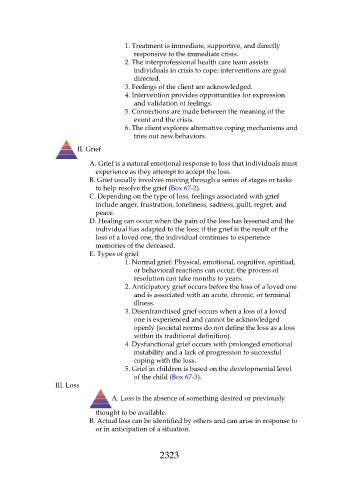Page 2323 - Saunders Comprehensive Review For NCLEX-RN
P. 2323
1. Treatment is immediate, supportive, and directly
responsive to the immediate crisis.
2. The interprofessional health care team assists
individuals in crisis to cope; interventions are goal
directed.
3. Feelings of the client are acknowledged.
4. Intervention provides opportunities for expression
and validation of feelings.
5. Connections are made between the meaning of the
event and the crisis.
6. The client explores alternative coping mechanisms and
tries out new behaviors.
II. Grief
A. Grief is a natural emotional response to loss that individuals must
experience as they attempt to accept the loss.
B. Grief usually involves moving through a series of stages or tasks
to help resolve the grief (Box 67-2).
C. Depending on the type of loss, feelings associated with grief
include anger, frustration, loneliness, sadness, guilt, regret, and
peace.
D. Healing can occur when the pain of the loss has lessened and the
individual has adapted to the loss; if the grief is the result of the
loss of a loved one, the individual continues to experience
memories of the deceased.
E. Types of grief
1. Normal grief: Physical, emotional, cognitive, spiritual,
or behavioral reactions can occur; the process of
resolution can take months to years.
2. Anticipatory grief occurs before the loss of a loved one
and is associated with an acute, chronic, or terminal
illness.
3. Disenfranchised grief occurs when a loss of a loved
one is experienced and cannot be acknowledged
openly (societal norms do not define the loss as a loss
within its traditional definition).
4. Dysfunctional grief occurs with prolonged emotional
instability and a lack of progression to successful
coping with the loss.
5. Grief in children is based on the developmental level
of the child (Box 67-3).
III. Loss
A. Loss is the absence of something desired or previously
thought to be available.
B. Actual loss can be identified by others and can arise in response to
or in anticipation of a situation.
2323

